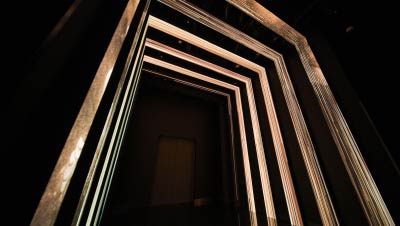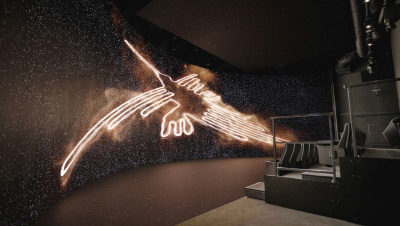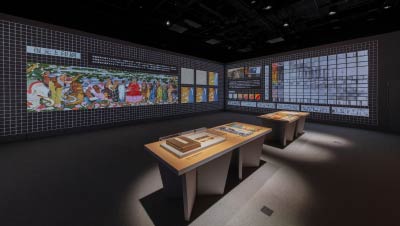XROSS
Digital
Museum
Through cultural assets,
past and future intersect,
as well as people and cultures.
Use your senses to enjoy
the Digital Museum.

Through cultural assets,
past and future intersect,
as well as people and cultures.
Use your senses to enjoy
the Digital Museum.
KOISHIKAWA XROSS Digital Museum
Location|1st Basement Floor of
Toppan Koishikawa Head Office Building,
1-3-3 Suido, Bunkyo-ku, Tokyo 112-8531
Closed|Mondays
*As a general rule, there is no general admission on weekdays. Prior reservations via our staff are required.
*The Museum's opening hours on Saturdays, Sundays, and public holidays follow the schedule of the Printing Museum, Tokyo.
The term “digital cultural assets,” which may seem unfamiliar to some of you, was coined by those of us at Toppan. We use it to describe an exhibition piece created with precise digital archive data sourced from cultural assets.
All visual works that can be viewed at the KOISHIKAWA XROSS Digital Museum, including interactive digital content and reproductions of folding screens, are digital cultural assets.
We hope our visitors will appreciate the charm and stories behind these digital cultural assets by viewing and interacting with the exhibited works, broadening the digital cultural asset community.
It is also our hope that our exhibition methods, which utilize digital technologies, will provide all museum visitors with insights they can implement in their businesses. We strive to turn the museum into a space that creates opportunities for co-creation.
Upon arriving at the KOISHIKAWA XROSS Digital Museum, visitors are greeted by an LED installation inspired by the traditional Japanese torii gates. The luminous diodes, which represent the beginning of digital archiving, guide visitors through the museum.



The VR Theater uses a giant 20-meter-wide and 5-meter-high curved LED screen to display 16K ultra-high definition VR imagery that provides visitors with a highly immersive and realistic experience. A navigator guides viewers around our virtual reality content while conveying the charm and stories behind various cultural assets from Japan and overseas.



This area introduces a wide variety of viewing experiences that utilize precise digital archive data recording actual colors and shapes of digital cultural assets. The gallery presents digital cultural assets in various forms, including an interactive viewing system linked to a large display.



This 110-square-meter exhibition space presents the latest projects on digital cultural assets. Some special exhibitions include immersive video projections from the floor to the walls and hypothetical digital reconstructions of lost cultural assets.
Currently, the room displays a reconstruction project of the legendary The Buddha and Sixteen Arhats, painted by one of the most famous painters of the Edo Period (1603-1867), Ito Jakuchu. The Buddha and Sixteen Arhats, which was created using an unusual method of masume-gaki (grid painting), has been lost. This project explores the yet unknown charm of Ito Jakuchu by recreating the folding screen based on a small black-and-white drawing, breathing life into it with modern, vivid colors.
Hypothetical digital reconstruction of Ito Jakuchu’s
The Buddha and Sixteen Arhats
Production: Toppan Inc.
Supervision: Yamashita Yuji (professor at Meiji Gakuin University);
Arai Kei (professor at Tokyo University of the Arts)




The museum requires prior reservations. If you are planning on visiting the museum, please reserve your tickets below.
Edogawabashi Station
Tokyo Metro Yurakucho Line (Exit 4), 8 minutes' walk
Iidabashi Station
JR Sobu Line (East Exit), Tokyo Metro Yurakucho Line,
Tokyo Metro Tozai Line, Tokyo Metro Namboku Line, and Toei Oedo line (Exit B1),
13 minutes' walk
Korakuen station
Tokyo Metro Marunouchi Line and Tokyo Metro Namboku line (Exit 1),
10 minutes' walk
Toei Bus (上69)
Ueno Koen—Kasuga Eki-mae—Otakibashi Shako
Get off at Omagari or Higashi-Gokencho and walk 3 minutes
Toei Bus (飯64)
Kudanshita—Iidabashi Eki-mae—Otakibashi Shako
Get off at Omagari or Higashi-Gokencho and walk 3 minutes
Bunkyo Ward Community Bus (B-Guru)
Mejirodai/Kohinata route, get off at Toppan Hall Printing Museum, Tokyo
bus stop and it is about a three-minute walk
KOISHIKAWA XROSS Digital Museum
Location|1st Basement Floor of Toppan Koishikawa Head Office Building, 1-3-3 Suido, Bunkyo-ku, Tokyo 112-8531
Closed|Mondays
*As a general rule, there is no general admission on weekdays. Prior reservations via our staff are required.
*The Museum's opening hours on Saturdays, Sundays, and public holidays follow the schedule of the Printing Museum, Tokyo. Please refer to its official website for details.
*Exhibits are subject to change without prior notice.
For inquiries regarding the KOISHIKAWA XROSS Digital Museum, please use the contact information below.
Upon arriving at the KOISHIKAWA XROSS Digital Museum, visitors are greeted by an LED installation inspired by the traditional Japanese torii gates. The luminous diodes, which represent the beginning of digital archiving, guide visitors through the museum.
The VR Theater uses a giant 20-meter-wide and 5-meter-high curved LED screen to display 16K ultra-high definition VR imagery that provides visitors with a highly immersive and realistic experience. A navigator guides viewers around our virtual reality content while conveying the charm and stories behind various cultural assets from Japan and overseas.
This area introduces a wide variety of viewing experiences that utilize precise digital archive data recording actual colors and shapes of digital cultural assets. The gallery presents digital cultural assets in various forms, including an interactive viewing system linked to a large display.
This 110-square-meter exhibition space presents the latest projects on digital cultural assets. Some special exhibitions include immersive video projections from the floor to the walls and hypothetical digital reconstructions of lost cultural assets.
Currently, the room displays a reconstruction project of the legendary The Buddha and Sixteen Arhats, painted by one of the most famous painters of the Edo Period (1603-1867), Ito Jakuchu. The Buddha and Sixteen Arhats, which was created using an unusual method of masume-gaki (grid painting), has been lost. This project explores the yet unknown charm of Ito Jakuchu by recreating the folding screen based on a small black-and-white drawing, breathing life into it with modern, vivid colors.